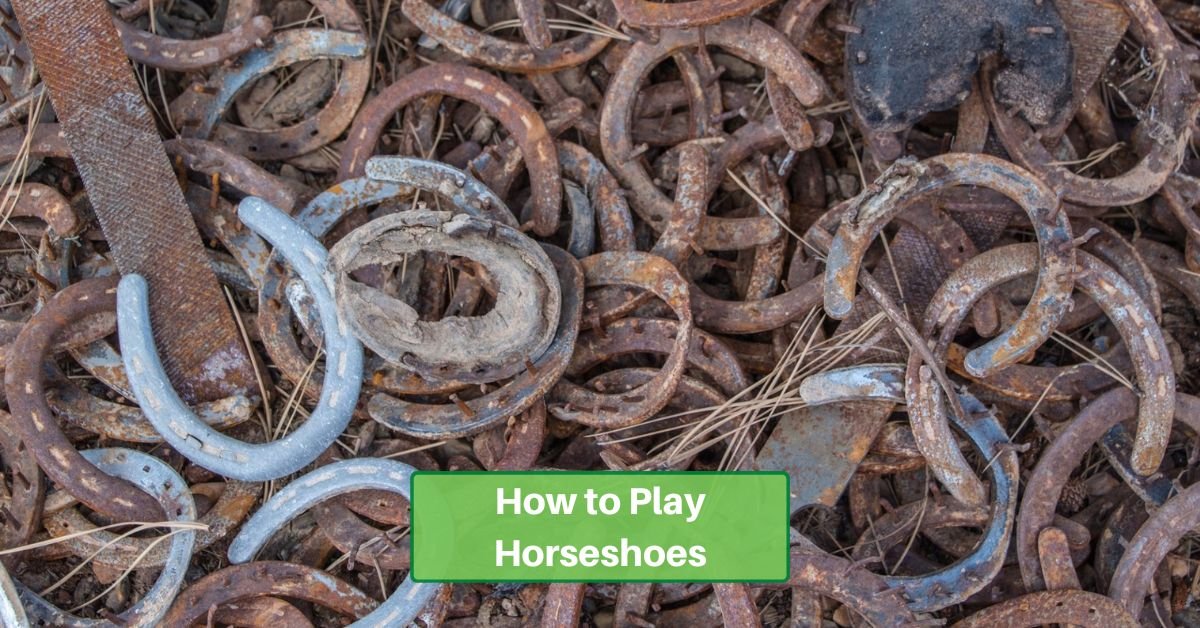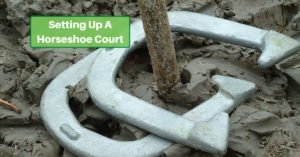Horseshoes is one of the greatest backyard games of all time. Most people have at least a rough idea of how to play – just throw the shoe and try to get it around the pole. But if you want to learn a bit more about the rules, we’ve got you covered!
Of course, there are “tournament” rules and then there are backyard rules. And when it comes to backyard rules, the variations are almost as numerous as the backyards the game is played in! We’ll stick closely to official rules – but feel free to adapt them to suit your circumstances.
Players
Horseshoes can be played by 2 or 4 players divided into two teams of two. Tournament rules set different lengths for the horseshoe pitch for men, women, and teens, but that’s not possible to accommodate in backyard games.
Terms To Know
Here are some important terms to know when it comes to the game of horseshoes.:
Calks
The raised parts at the heel and toes of the horseshoe. At the toe, the calk is a helpful spot to grip the shoe. The calks also help keep the shoe from sliding when it hits the ground after being pitched.
Double Ringer
Consecutive ringers by the same player. See ringer.
Flipped Up Shoe
A method to determine which team or player pitches first, similar to flipping a coin. The shoe is tossed in the air so that it spins and one player/team chooses heads (calks up) or tails (calks down). The winner can choose to pitch first or choose which end they would like to pitch from first.
You could also flip a coin, play rock-paper-scissors, or use another random means to determine who goes first.
Heel
The prongs at the open end of the horseshoe.
Inning
Each player takes their turn; that is, each pitches two horseshoes.
Leaner (Hobber)
A pitched shoe that leans on or touches the stake but is not a ringer.
Pit
The area around the stake, usually boxed in and filled with sand.
Pitch
- The entire area for playing horseshoes, including the pits, pitcher boxes, and the space in between
- To throw a horseshoe
Pitcher Box
The pit plus the space behind or beside it from which the player pitches their horseshoes.
Ringer
A shoe that encircles the stake. A ringer is counted when the stake is “within” the shoe and a line can go from one prong to the other without going through the stake.
Toe
The toe is the “closed” side of the horseshoe, the side that is held to pitch the shoe.
Equipment
You don’t need much to play horseshoes, especially if a pitch is already set up.
Beyond that, you simply need a set of four horseshoes – two for each side.
If you don’t have a pitch yet, check out our guide to setting one up!
How To Pitch A Horseshoe
A horseshoe is normally held at the heel, using the calk to provide stability.
It’s thrown underhand toward the stake at the opposite end of the pitch. The best results are usually achieved by pulling the arm backward and following through when the shoe is released.
Before pitching a horseshoe, be sure no people or pets are between you and the stake, or within about 2 yards of the stake.
How To Play
Players stand at opposite ends of the horseshoe pitch and take turns pitching toward the far stake.
They take turns pitching one shoe at a time. After each pitches their horseshoes, the inning ends and the score is counted.
The final position of the shoes is what counts. At times, a shoe may hit one previously pitched and cause it to move; only the position at the end of the inning counts.
After the inning, players alternate ends of the pitch.
If you’re playing in teams, each player pitches one shoe per inning.
Scoring
Normally, a game is played until one player or team reaches a predetermined point total. Eleven (11) and 21 are common goals.
A ringer counts as 3 points.
Some people count a leaner as 2 points. However, others count it as only one
Any other shoe that is within 6 inches of the stake counts as 1 point. Since a horseshoe
Some people require that the winner score exactly 21 points. In other words, if you have 19 and make a ringer, it doesn’t count.
Another fun – and irritating – rule would be if you go over, then you have to deduct the overage from 21. If you were at 20 and made a ringer, bringing your total to 23, you went two points over (23-21), so you go back to 19 (21-2). That version is sometimes called the “bust out” rule.
Alternatively, you can play a set number of innings; the winner is, of course, the person or team with the highest score.
Conclusion
Horseshoes is a wonderful yard game with simple rules. And you can adjust those rules to meet your own preferences – just be sure everyone knows them ahead of time! Stay safe, because getting hit with a horseshoe can be dangerous. Above all, enjoy your time on the pitch!









